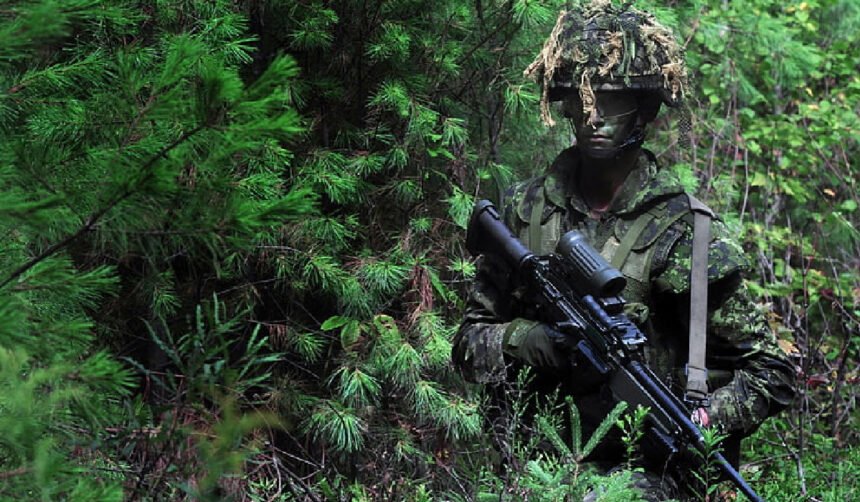Introduction
When it comes to surviving and thriving in the great outdoors, few tools are as important as reliable shelter and concealment. Whether you’re a soldier on a mission, a camper exploring the wilderness, or a photographer capturing rare wildlife moments, your gear must be tough, discreet, and dependable. This is where Tarnplanen excels. Originating from Germany, this camouflage tarpaulin is engineered for extreme environments and various outdoor scenarios. It combines the effectiveness of military camouflage with the ruggedness of durable fabric, making it a favorite among adventurers and tactical professionals.
In this article, we will dive into everything you need to know about Tarnplanen—its meaning, origin, materials, applications, travel usage, how to choose the right one, and much more. By the end, you’ll see why this isn’t just a tarp—it’s a smart investment for protection and survival in any terrain.
What Is Tarnplanen? – Meaning, Origin, and Concept
The term Tarnplanen comes from the German language, combining “Tarn,” which means camouflage, with “Planen,” which translates to tarpaulin or cover. Thus, the literal meaning of Tarnplanen is “camouflage tarp.” These specially designed covers are built to blend into natural or tactical environments, offering both concealment and protection. Originally developed for the German military, Tarnplanen quickly became a vital resource in field operations where visual concealment could mean the difference between success and failure.
Over time, the concept extended beyond the battlefield, finding new relevance in outdoor activities such as camping, hunting, survival training, and tactical photography. The principle behind Tarnplanen lies in combining strategic camouflage patterns with strong, weather-resistant materials to create a multipurpose outdoor solution. It not only hides the user or their gear but also shields them from the elements, making it a must-have item for anyone venturing into unpredictable or hostile environments.
A Brief History of Camouflage and Tarnplanen
Early Uses of Camouflage in Nature and Warfare
Camouflage as a concept is rooted in nature, where animals like chameleons, tigers, and stick insects evolved patterns to blend into their surroundings for protection and hunting. Early humans observed and mimicked this behavior to enhance their own survival, especially during hunting. In ancient warfare, fighters painted themselves or used natural materials like mud and leaves to become less visible. However, the modern evolution of camouflage began during World War I, when military strategists saw the need to protect soldiers and equipment from aerial reconnaissance. They developed disruptive patterns to confuse enemy eyes and distort outlines, laying the foundation for the modern camouflage used in tools like Tarnplanen.
Military Origins of Tarnplanen
The Tarnplanen itself was introduced by the German military and became a standard component in field kits. These tarps were used to conceal personnel, vehicles, and supplies, especially during covert operations. In the Cold War era, NATO forces and German Bundeswehr troops adopted advanced versions of Tarnplanen to meet the growing demands of tactical warfare.
These tarps featured reinforced grommets, improved waterproofing, and camouflage suited to European terrain. Eventually, as military surplus hit the civilian market, outdoor enthusiasts recognized the value of these well-crafted, reliable tarps. They became a staple in bushcraft communities, survivalist kits, and extreme adventure gear.
Core Materials and Technology Used in Tarnplanen
Fabric Types
Tarnplanen are made from high-performance materials like ripstop nylon, polyester, canvas, and PVC-coated fabrics. Ripstop nylon is light yet resistant to tearing due to its interwoven reinforcement threads. Polyester is known for its low stretch and colorfastness, ideal for long sun exposure. Canvas versions, though heavier, offer superior breathability and long-term durability. PVC-coated tarps, on the other hand, offer unmatched waterproof protection, making them ideal for prolonged exposure to rain or snow. Each material has its advantages depending on the mission or environment, but all are chosen for their ability to survive in harsh, outdoor conditions.
Coatings and Treatments
What sets Tarnplanen apart is the application of advanced coatings that enhance performance. Most are waterproof or water-resistant, preventing water ingress during storms or heavy rainfall. Others come with UV-resistant finishes to prevent fading and material breakdown when exposed to the sun for long periods. Many models are also treated with anti-mildew agents, especially helpful in tropical or humid climates. In some cases, fire-retardant coatings are added for safety in areas prone to wildfires or for use near campfires, adding an extra layer of protection for survivalists and campers.
Stitching, Grommets, and Reinforcements
Durability is a hallmark of quality Tarnplanen. That’s why many include double-stitched edges, reinforced corners, and metal grommets for easy attachment and anchoring. The grommets are often made of rustproof brass or aluminum, ensuring long-term use in wet environments. Reinforced hems prevent fraying and help maintain the tarp’s shape under tension. These small details contribute to a longer lifespan and increased reliability under extreme usage scenarios.
Primary Uses of Tarnplanen – More Than Just a Tarp
Military and Tactical
Tarnplanen was first created for military operations, and its tactical value remains unmatched. Soldiers use it to cover vehicles, equipment, and personnel during missions in forests, deserts, or urban environments. Snipers and reconnaissance units also rely on Tarnplanen to build quick concealment structures or temporary shelters that go unnoticed. The ability to stay hidden from aerial drones or enemy patrols makes Tarnplanen indispensable in modern warfare.
Camping, Hiking, and Bushcraft
For campers and bushcrafters, Tarnplanen serves as an instant shelter, ground sheet, or weatherproof gear cover. It is light enough to carry in a backpack but strong enough to provide cover during rain, wind, or snow. The camouflage aspect also allows for discreet camping, ideal for stealth campers or those who prefer minimal environmental disturbance. In rugged terrains or off-grid adventures, Tarnplanen becomes both a comfort and a survival asset.
Photography, Wildlife Observation, and Filmmaking
Wildlife photographers and documentarians benefit immensely from Tarnplanen’s ability to blend into the environment. It allows them to observe and film animals without alerting them. Whether shooting endangered species in Africa or birds in a European forest, remaining undetected is key—and Tarnplanen provides that advantage.
Emergency and Prepper Use
In emergency situations, Tarnplanen is an ideal makeshift shelter, windbreak, or water collector. It can even be used to create stretchers, body bags, or camouflaged storage covers for prepper caches. Its versatility makes it an essential component of any bug-out bag or emergency survival kit.
Travel and Global Adventure Use of Tarnplanen
Tarnplanen in Backpacking and Motorcycle Touring
Backpackers and motorcycle adventurers often choose Tarnplanen because of its lightweight portability and compact packing. Exploring remote regions it provides instant shelter while protecting gear from theft and harsh weather. The camouflage design also helps prevent unwanted attention in less secure areas, giving travelers peace of mind.
Use in Survival Tourism and Remote Expeditions
Modern survival tourism often leads travelers into jungles, deserts, arctic zones, or mountains—environments where protection from the elements and blending into surroundings is crucial. Tarnplanen is used for everything from emergency bivy shelters to field hospitals or gear concealment during trekking expeditions.
Tarnplanen at Music Festivals and Outdoor Events
Even in non-survival scenarios like music festivals, Tarnplanen proves useful. People use it to create privacy shelters, cover their camping gear, or build shaded areas. Its aesthetic and functional appeal make it a go-to solution for those seeking both style and protection at outdoor events.
How to Choose the Right Tarnplanen
Selecting the right Tarnplanen depends on several key factors including size, shape, material, camouflage pattern, and intended use. First, consider the size—smaller tarps (2×2 meters) are suitable for solo travelers or covering backpacks, while larger sizes (3×4 meters or more) are ideal for family camping or vehicle concealment. Next, think about the shape. Rectangular Tarnplanen are best for lean-to shelters and ground coverage, while square shapes offer versatility for hammocks and tents.
When it comes to materials, ripstop nylon and polyester are lightweight and portable, perfect for backpacking. Canvas and PVC-coated options are heavier but provide superior durability and long-term protection. The camouflage pattern is equally crucial—choose woodland camo for forests, digital camo for urban or mixed terrain, and desert tones for arid landscapes. Finally, assess portability and packability if you’re on the move. A foldable, lightweight Tarnplanen with reinforced grommets and weatherproof coatings ensures reliable performance for your specific adventure.
Setup Techniques – How to Use Tarnplanen Effectively
Effective setup of Tarnplanen can make the difference between staying dry and being exposed to the elements. Start by identifying your environment and purpose—shelter, gear cover, or concealment. For shelters, try the A-frame, lean-to, or diamond fly configurations using paracord tied to trees or poles. Always anchor the corners through reinforced grommets to avoid tearing. In windy conditions, use rocks, stakes, or logs to weigh down the edges.
When setting up on uneven terrain, elevate one side slightly to allow rain runoff. For camouflage concealment, consider your light source and background. Use natural materials like branches and leaves to break up unnatural outlines and help the Tarnplanen blend into the environment. Avoid overly tight setups that stress seams, and always allow a slight curve to absorb wind shock. These techniques not only protect you from the elements but also help you remain undetected in both tactical and wilderness scenarios.
Tarnplanen Maintenance and Care
Proper care of your Tarnplanen ensures it remains functional across seasons. After each use, shake off dirt, leaves, or snow, then clean with cold water and mild soap using a soft brush or cloth. Avoid using bleach or harsh chemicals that can degrade waterproof coatings. Always let the Tarnplanen dry completely before storage to prevent mold, mildew, or foul odors. Store it folded loosely in a cool, dry place, away from direct sunlight to prevent UV degradation.
Over time, inspect grommets and seams for wear. Small tears or holes can be patched with tarp tape, adhesive fabric patches, or seam sealer. Reinforce frayed edges with gaffer tape until proper repairs are made. With routine maintenance, your Tarnplanen will withstand years of rugged use in even the most extreme outdoor environments.
Where to Buy Tarnplanen – Trusted Sources
When purchasing Tarnplanen, always opt for trusted retailers to ensure quality and authenticity. Military surplus stores offer original Bundeswehr or NATO-issued Tarnplanen, often at reasonable prices with proven durability. For new and specialized options, outdoor retailers like Helikon-Tex, REI, Decathlon, and Survival Frog carry high-performance models designed for different terrains and weather conditions.
Online platforms such as Amazon, eBay, or Varusteleka provide customer reviews that help you judge real-world performance. When shopping online, use search terms like “military-grade Tarnplanen,” “camouflage tarp with eyelets,” or “PVC camo cover.” Look for certifications like “100% waterproof,” “UV protection,” or “tear-resistant.” Avoid low-quality replicas that use cheap materials and fade quickly. Investing a bit more upfront will guarantee better performance, longer lifespan, and peace of mind during your travels.
Popular Brands Making Tarnplanen Today
Several trusted brands dominate the Tarnplanen space, each offering unique strengths:
| Brand | Material | Weight | Waterproof | Camo Type | Price Range |
|---|---|---|---|---|---|
| Helikon-Tex | Ripstop Poly/Nylon | Medium | ✅ | MultiCam, Woodland | $$$ |
| Mil-Tec | PVC/Canvas | Heavy | ✅ | German Flecktarn | $$ |
| Aqua Quest | Nylon/PVC-Coated | Light | ✅✅ | Neutral Forest | $$$ |
| Rothco | Poly/Cotton | Medium | ✅ | Desert, Urban | $$ |
| Surplus Gear | Canvas | Heavy | ⚠️ Some | Original Bundeswehr | $ |
Each brand offers a variety of sizes and camo styles. Choose Helikon-Tex for tactical reliability, Mil-Tec for rugged durability, Aqua Quest for ultralight expeditions, Rothco for affordable versatility, and genuine surplus for authenticity.
The Art and Science of Tarnplanen Camouflage
Tarnplanen camouflage is a blend of science and visual psychology, designed to distort and hide shapes in natural or urban environments. The effectiveness comes from patterns that disrupt the human eye’s ability to distinguish outlines. Digital camo uses pixelated shapes that confuse depth perception, making gear or people less visible at a distance. Analog camo, such as woodland or tiger stripe, imitates foliage and shadows to blend with surroundings.
The science lies in how our brains interpret light and movement—Tarnplanen patterns reduce contrast with the background, helping them merge with terrain. Moreover, natural light, shadows, and movement affect visibility. When properly placed and supplemented with brush, dirt, or snow, Tarnplanen becomes nearly invisible. Its design is a perfect example of functional art—merging utility with a deep understanding of how humans perceive their environment.
Tarnplanen vs. Standard Tarpaulins
| Feature | Tarnplanen | Standard Tarp |
|---|---|---|
| Camouflage | ✅ | ❌ |
| UV Resistance | ✅ | ⚠️ Limited |
| Reinforced Grommets | ✅ | ⚠️ Sometimes |
| Portability | ✅ | ✅ |
| Military Use | ✅ | ❌ |
Tarnplanen clearly outperforms standard tarps in stealth, ruggedness, and multi-functionality. While standard tarps may be cheaper, they lack advanced materials, reinforced stitching, and tactical camouflage. For outdoor adventurers, survivalists, or military personnel, the choice is clear—Tarnplanen offers superior performance with professional-grade features.
Advanced Travel Tips with Tarnplanen
When traveling with Tarnplanen, consider it a multifunctional survival tool, not just a shelter. Use it with hammocks as a rainfly or wind block. In urban exploration or stealth camping, choose patterns that match the built environment. Pack paracord, carabiners, and stakes for quick setup anywhere. For privacy during festivals or long bus rides, use Tarnplanen as a temporary wall or curtain.
In legal terms, some countries restrict military camo—so if you’re visiting certain African or Caribbean nations, opt for neutral camo or solid earth-tone tarps. Always research local regulations before traveling with military-looking gear. Knowing how to deploy your Tarnplanen quickly and discreetly can turn any unplanned stop into a safe resting place.
Final Thoughts
Tarnplanen is not just a tarp—it’s a comprehensive outdoor solution trusted by military units, survivalists, adventurers, and everyday travelers. Its durability, portability, camouflage functionality, and weather resistance make it an indispensable part of any gear setup. From hiding your shelter in a dense forest to protecting your equipment during a desert storm, Tarnplanen adapts to your environment and your needs.
It represents the perfect fusion of tactical engineering and practical design, born from military necessity and refined for global adventurers. Whether you’re navigating remote trails, setting up a survival base, or simply enjoying nature under the stars, Tarnplanen delivers security, stealth, and strength where it matters most. Don’t just pack a tarp—pack confidence with Tarnplanen.
FAQs About Tarnplanen
What is Tarnplanen used for?
Tarnplanen is used to provide camouflage and weather protection. It hides people, gear, or shelters in outdoor areas and keeps them safe from rain, sun, and wind.
Is Tarnplanen waterproof?
Yes, Tarnplanen is waterproof. Most Tarnplanen are coated with special layers that block rain and keep everything underneath dry in wet weather.
Can Tarnplanen be used for camping?
Tarnplanen is perfect for camping. You can use it as a tent cover, ground sheet, or quick shelter in forests, mountains, or deserts.
Is Tarn planen easy to carry while traveling?
Yes, Tarnplanen is lightweight and easy to carry. It folds small and fits in backpacks, making it great for travel, hiking, or survival trips.
Where can I buy real Tarn planen?
You can buy Tarnplanen from military surplus stores or online shops like Amazon, Helikon-Tex, and eBay. Always check for waterproof and UV protection labels.
You May Read Also: HMS Photovoltaik: Smart Solar Innovation That Transforms Clean Energy
For More Information, Visit Dotmagazine









